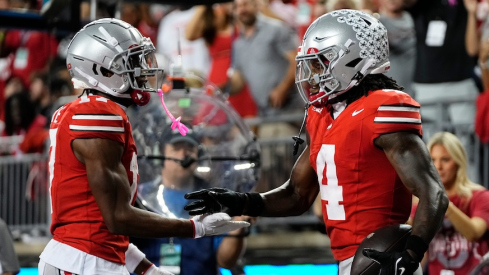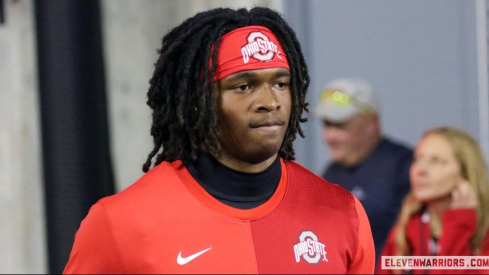
After focusing on the defense, I now want to move on to a position-by-position basics for the Ohio State offense, beginning with the wide receivers.
As with the defense, Ohio State has noticeable variations within their wide receiver positions. The primary distinction is between inside and outside receivers, as discussed below.
H (Slot) Receiver
The most important receiver position for an Urban Meyer offense is the H slot position. Meyer and his staff use this position to attack the middle of the field within 15 yards of the line of scrimmage.
The H receiver focus fits with Meyer's overall philosophy by forcing defenses to account for the numbers OSU applies in its base run game. These leaves holes behind vacating linebackers where the H receiver can work.

Meyer likes putting his best athletes at H to exploit the remaining linebackers and safeties. For instance, a base Meyer pass play is "H-Y option." The play is an organized version of backyard football with the H receiver attacking the curl/flat defender to his side attempting to break open inside or outside based upon the coverage.
On this play, H wants to run right at the inside defender, attacking the defender's inside leverage to beat him inside. If he cannot, he will plant and cut outside. If he is bracketed, he will hook and settle down. If he cannot get open on this initial cut, he has the freedom to cut across the middle on a shallow cross.

The H receiver is typically a hybrid receiver and running back – shorter, squattier, and quicker in space than your traditional receiver. The classic Meyer example is Percy Harvin. Meyer wants to get H the ball underneath in the open field and allow him make plays. Like a fast break on turf with H receiving the outlet pass for the break.
Meyer will also send the H in "HIC" motion into the backfield. Depending on that player's ability, the H can do anything from being the option man off zone read to taking the hand-off on inside-run plays.
Last year, Corey Brown bumped down to H in 3rd down situations. Look for Brown to continue to move around as he Buckeyes utilize their No. 1 receiver. But Jordan Hall will also get extensive run at H. More quick than fast, Hall can use that quickness to exploit defenders on underneath routes. He is obviously also a run-game threat.
Plenty of Room
Ohio State needs more than one slot receiver. In base downs, the Buckeyes generally use what's called 11 personnel, meaning 3 WRs, 1 TE, and 1 RB. The tight end or Y receiver will move between a traditional tight end position, an H-back in the backfield, or an offset fullback.

The Y receiver can also be a passing threat similar to the H, attacking on the opposite side with option routes or down the seam.
Meyer's offense will quickly switch to four or five wide receivers, removing the Y for a second H receiver. In addition to Brown and Hall look for two freshmen, Dontre Wilson and Jalin Marshall, to get significant opportunities.
Wilson and Marshall have drawn rave reviews at fall practice and bring slightly different qualities. Wilson is a classic scat back while Marshall is bigger and has the ability to quickly hit top speed. Both, however, can turn running plays or underneath receptions into big plays. Unlike last year when the staff had no choice but to slide Brown inside, this year the Buckeyes have the potential to threaten the defense from both slots.
Mix and Match
While the H gets much of the attention in Meyer's offense, the outside receivers are not forgotten. Brown did much of his damage last year operating from the flanker or Z position. The Buckeyes like attacking with the Z receiver using sprint-outs and snag routes.
Meyer generally looks for taller, what one may call traditional receivers on the outside, but he also likes to mix receivers with different strengths. Meyer would like to have one receiver that can attack underneath and churn out first downs. He then wants the other to attack down field and be the deep threat.
The Buckeyes seem to have that in Brown and split end or X receiver Devin Smith. As noted, Brown was the Buckeyes' go-to receiver on 3rd down, while the Buckeyes used Smith to attempt to take the lid off the defense.
The goal for Brown and Smith is to improve other aspects of their game. For Brown, it is yards after catch, and for Smith, it is becoming a more well-rounded receiver. Both have shown improvement in those areas with Smith, for instance, being able to exploit defenses on hitch and out routes against soft coverage.
The Buckeyes have other receivers competing to gain playing time. Guys such as Evan Spencer, Mike Thomas, Corey Smith, and James Clark are all looking to fit as additional outside receivers.
The good news for Urban Meyer and his staff is that they have options this year, unlike what they faced in 2012.

